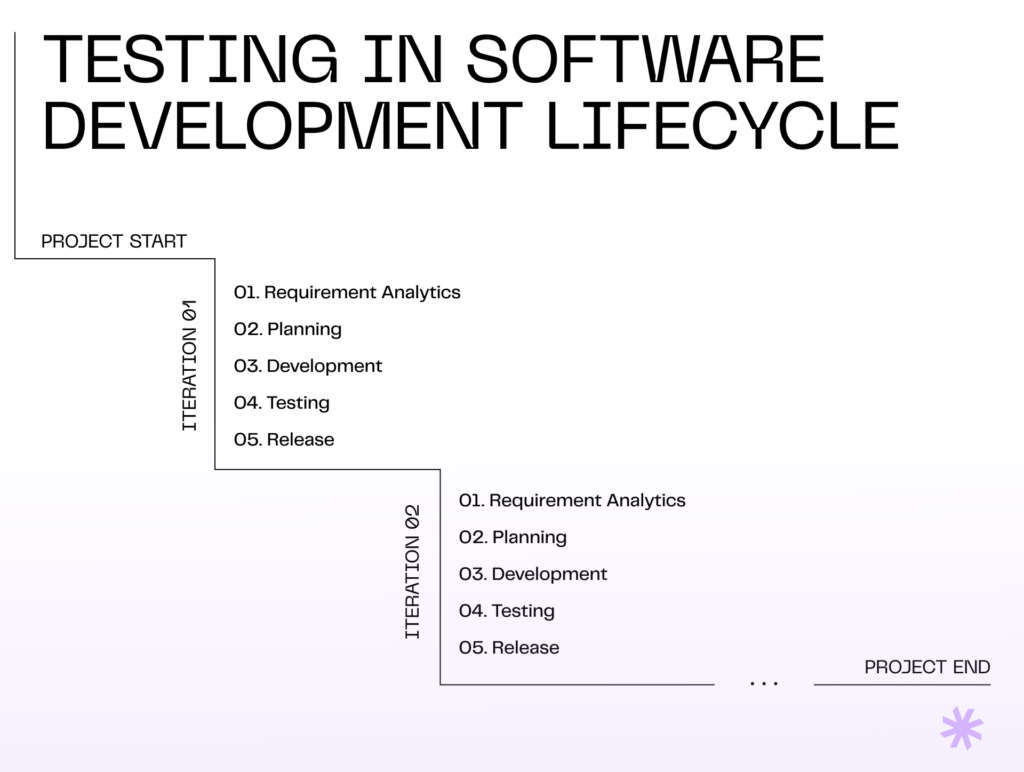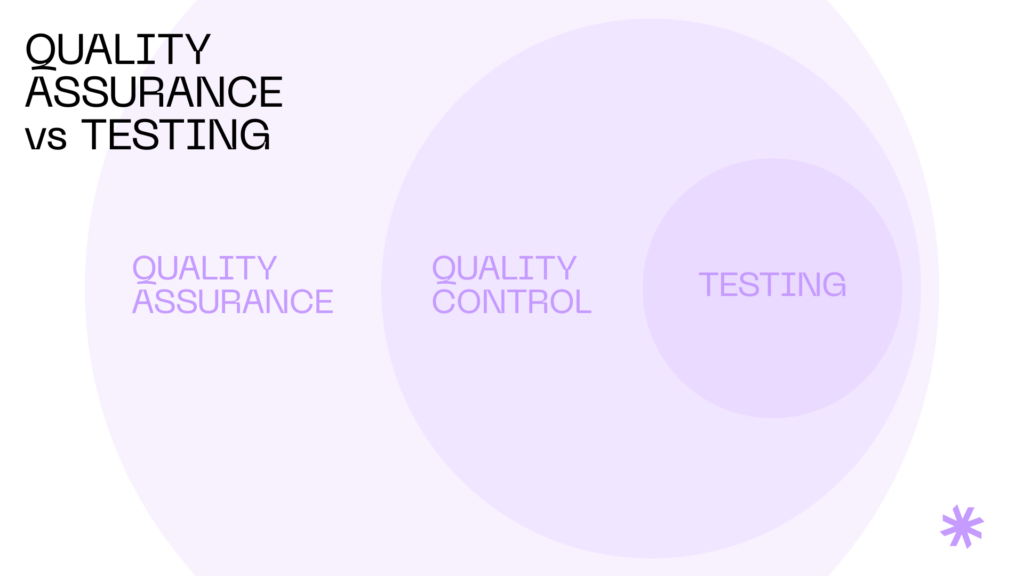Quality Assurance and Testing are not the same thing. However, during my time as a QA engineer at Syndicode, I’ve noticed a lot of confusion around this statement.
Apparently, people tend to use the terms interchangeably due to the growing prevalence of Agile methodologies, which results in overlapping responsibilities. In many projects, QA teams end up doing both tasks, which can make it seem like these terms mean the same thing.
However, there are some significant differences between QA and Testing, which I’ll clarify in this article. We’ll also explore why it’s crucial for business owners and software development teams to have a clear understanding of these distinctions.
Let’s start with some definitions.
What is software testing?
Software testing involves examining a software application or system to detect issues such as bugs or discrepancies between expected and actual results. The primary goal is to identify and fix these problems. Typically, testing takes place after the development phase is completed.
In Agile software development, which divides product development into iterations, testing occurs in each iteration. It happens after the piece of software planned for that specific iteration has been completed.

Testing teams use various tests to assess different aspects of a software product, including functional, non-functional, and acceptance testing. Key testing activities include:
- Test planning
- Test case development
- Text execution
- Test reporting
For a more in-depth exploration of the software testing lifecycle (STLC), you can refer to our earlier blog post. There, you’ll find information on testing techniques, their goals, and an example illustrating how STLC works in a project.
Benefits of testing in software development
Testing is an indispensable part of the software development process for the following reasons:
- Cost savings. Testing helps identify bugs and defects before the software is released to the end user, preventing costly post-release issues;
- Enhanced software reliability as it ensures that the software meets the specified requirements and functions as intended;
- Compliance with standards as testing ensures that the product meets the requirements precisely and helps businesses avoid legal and regulatory issues.
What is software quality assurance (QA)?
Software Quality Assurance (QA) is a process designed to ensure that quality-focused procedures and activities are implemented and followed throughout the SDLC. Its main objective is to establish a framework for delivering high-quality software products.
QA goes beyond merely checking the end product against requirements; it aims to prevent potential issues and enhance the productivity of the development team.
QA is integrated into the development process, involving the entire team, including stakeholders, business analysts, developers, and testers.

Key QA activities include:
- Requirement analysis
- Test planning
- Test case creation
- Test execution and defect reporting
It’s worth noting that there is some overlap between the activities of QA and testing, as testing is a subset of QA.
Benefits of quality assurance in software development:
- Early issue detection: QA activities begin at the project’s initiation, facilitating early issue detection and resolution and reducing the cost of fixing defects later in the development cycle.
- Development process improvement: QA establishes standards and best practices, ensuring that the software development process is consistent, efficient, and adheres to quality guidelines.
- Risk management: QA helps identify and address potential problems proactively.
- Resource optimization: QA helps identify areas for improvement, including skill development, process automation, and better utilization of resources.
At Syndicode, we emphasize the importance of involving quality assurance from the project’s outset as not only a best practice but also a strategic imperative. This reflects our dedication to delivering top-quality software solutions to our clients.
Read also: Why is quality assurance important?
Improve the quality of your software
Syndicode provides advice and resources to help you establish control over your product’s quality components. See what we can do for you.
Check servicesThe difference between QA and testing
So, what’s the difference between testing vs. Quality Assurance in software engineering? Let’s sum up:
| Aspect | Testing | Quality Assurance |
|---|---|---|
| Primary Goal | Identify defects and issues in the software | Improve processes, implement quality management practices, and mitigate risks |
| Scope | Narrow, focuses on the verification of specific functionalities and features | Broad, encompasses various processes, methodologies, and standards to maintain overall product quality |
| Focus | Validating the software against specified requirements and use cases | Establishing and maintaining consistent quality standards and processes |
| Timing | Typically occurs during the execution phase of the project | Implemented throughout the entire Software Development Life Cycle (SDLC) |
| Role within SDLC | A subset of QA; primarily concerned with defect identification | Encompasses a wide range of activities, including process optimization and adherence to quality standards |
| Activities | Test planning, test case design, execution, defect reporting, and test automation | Process improvement, defining and implementing best practices, auditing, standards adherence, and continuous improvement |
| Deliverables | Test plans, test cases, test results, defect reports, and test automation scripts | QA processes, best practices, quality metrics, quality standards, and process documentation |
| Customer Satisfaction | Indirect impact by identifying and preventing defects that could lead to customer dissatisfaction | Directly enhances customer satisfaction through process improvement and consistent quality |
| Responsibility for Process Improvement | Limited focus on process improvement, primarily concerned with identifying defects | Primary responsibility for process optimization and improvement |
| Risk Management | Limited involvement in risk management, mainly focused on defect identification | Identifies and mitigates potential risks throughout the SDLC, reducing unexpected issues |
| Cost Savings | Early defect detection can reduce the cost of fixing issues in later development stages | Cost savings through process optimization, reduced rework, and fewer post-release defects |
QA vs. testing: what to choose?
The choice between software testing & quality assurance depends on the project’s size, goals, and constraints.
Technically, QA encompasses testing activities, so a full QA implementation includes testing. However, in certain situations, testing without a formal QA process may be considered.
When can you choose testing without QA?
At Syndicode, we generally advise against skipping QA, but there are scenarios where testing alone might be justifiable:
- Limited scope: small projects with few features are less likely to have complex interactions and potential issues, making a full QA process less practical;
- Short timeframe: when the primary goal is rapid development and deployment, a comprehensive QA process may introduce delays;
- Limited resources: in projects with a small development team and constrained resources, dedicating individuals solely to QA activities might be impractical;
- Exploratory development: projects involving experimental features with evolving requirements and frequent changes may find QA activities challenging and less beneficial.
Considerations for implementing testing without a formal QA process
Despite the fact that leaving out QA is possible, you should know about the risks of omitting it and relying solely on testing:
- Unstructured testing: without a formal strategy, the testing process might become chaotic, leading to incomplete test coverage and miscommunication between the team members;
- Reduced prevention focus: lack of process reviews and audits may shift the focus more toward reactive testing, fixing issues after they occur rather than preventing them. This may lead to increased costs and longer time-to-market;
- Dependency on individual expertise: testing without QA may rely heavily on the expertise of individual testers rather than following standardized practices. This puts consistency and knowledge transfer at risk.
In summary, skipping quality assurance may be justified in lightweight development approaches. However, where testing is conducted informally, it’s still important to prioritize the identification and resolution of critical issues.
Still, this is context-specific and more applicable to small-scale projects or prototypes. For larger and critical projects, a well-established QA process is crucial to ensure software quality, minimize risks, and deliver a reliable product.
QA and testing: how we do it at Syndicode
At Syndicode, maintaining high standards in our projects is a fundamental aspect of our work. Our quality assurance process kicks in once we’ve gathered and clarified project requirements, and it continues until the product is ready to go live.
This approach helps us ensure the success of the products we work on. One of our favorite projects, MedYouCate, is an educational platform for healthcare professionals and medical students. Starting as a unique product in the European market, it has now evolved to feature over 600 training videos and recently earned a prestigious German Brand Award.
They collaborate with business analysts and the development team to create a list of completed and pending QA activities, ensuring everything aligns with the business needs. Their key focus areas include:
- Reviewing the existing product’s business logic to verify consistency, alignment with business needs, and compliance with the latest requirements;
- Identifying development project risks and providing recommendations to enhance team productivity and user experience;
- Participating in sprint planning to ensure compatibility and seamless integration of planned development into the existing product;
- Crafting test plans, cases, and analyzing testing results;
- Logging identified bugs into the defect log and overseeing their resolution.
One project where we entered later in its life cycle is Evrlearn, a B2C marketplace connecting education providers and learners. Our task was to enhance the website’s performance and add new features, contributing to the project’s success.
Our team has done a brilliant job implementing complex functionalities while improving the performance of the website and ensuring its user-friendliness. Currently, Evrlearn boasts an expanded course base of over 3,000 programs and continues to grow its user base. Syndicode remains dedicated to providing ongoing technical maintenance to the platform.
Summary
It’s crucial to recognize that testing and Quality Assurance are distinct concepts despite their overlapping goals and activities.
Understanding the difference between QA and testing is key to making informed decisions for your software development projects, optimizing resource allocation, and mitigating risks.
If you have questions or uncertainties about the most suitable quality management measures for your specific project, feel free to reach out to us. We have the right people to offer advice and provide resources to assist you in implementing and overseeing quality assurance and testing functions effectively.
